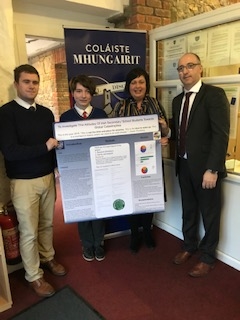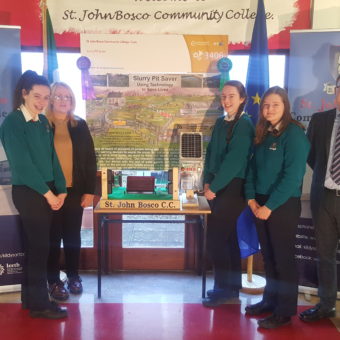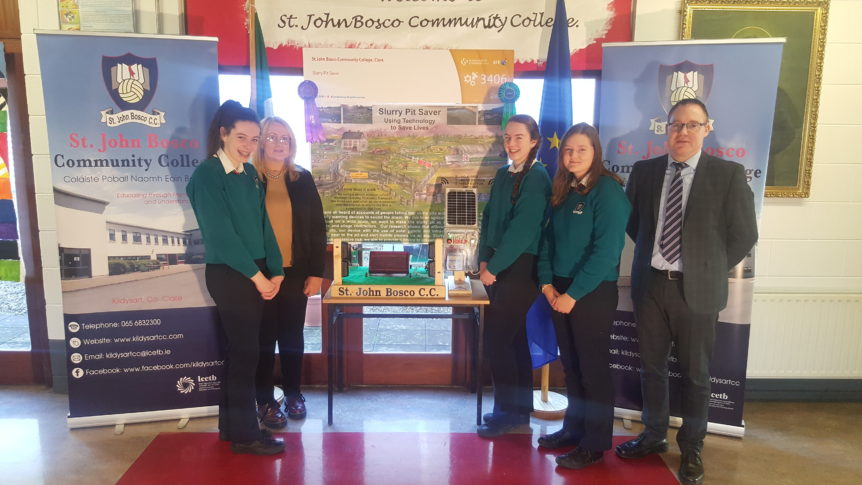Limerick and Clare Education and Training Board is delighted that several of its schools achieved outstanding awards and positive acknowledgements in the BT Young Scientist & Technology Exhibition at the RDS, Dublin, 8-11 January 2020.
A total of fifteen (15) projects, from Limerick and Clare Education and Training Board schools, qualified for the BT Young Scientist & Technology Exhibition at the RDS, Dublin, 8-11 January 2020.
George O Callaghan, Chief Executive of Limerick and Clare Education and Training Board, congratulated the students, their teachers and parents as well as the schools on their wonderful achievements at the exhibition. He said: “Limerick and Clare Education and Training Board is extremely proud of the its students and their teachers across Limerick and Clare who achieved such outstanding recognition for their innovative and impressive projects”. Mr. O Callaghan conveyed his sincere gratitude and praise of all who work to make the BT Young Scientist Exhibition the national success story it is in “celebrating the brightest and most innovative young people in Ireland”. He also praised the Limerick and Clare based companies who support the Exhibition with very generous special prizes across a wide range of specialisms including; Analog Devices, Cook Medical, Johnson and Johnson, Limerick for Engineering, Regeneron and university of Limerick.
The winning schools include Castletroy Community College, Mungret Community College and St. John Bosco Community College, Kildysart, Co. Clare.
Castletroy Community College
Title: Bin Buddy – A SMART Sorting Bin
James O Malley and Cathal O Mara (Junior Technology category)
Winners of Environmental Protection Agency special prize and Overall Runner-up Group
Created ‘Bin Buddy’, a smart sorting bin that recognises and sorts waste into recyclables and compost. The boys created a data set of more than 22,000 images and used code to train the bin to recognise recyclables and compostable waste. The bin comes equipped with a camera to snap a picture of the waste. That image is then sent to a Raspberry Pi computer and, using image recognition software, can move a chute at the bottom of the bin. Two motors connected move the chute in the direction of the correct waste bin and drop the trap door; and the piece of waste falls into the correct compartment in the bin.
Title: A Plastic for Our Planet – Toward a Sustainable Biodegradable
Orna Collins (Junior Chemical, Physical and Mathematical category)
Winner of 2nd place in Junior Chemical, Physical and Mathematical category
Create a sustainable biodegradable – a plastic for our planet. Orna created a bioplastic entirely from food waste and contrasted this bioplastic to blended bioplastic films from two other start sources (potato starch and corn starch). Glycerol was used as a plasticiser to decrease the plasticity and viscosity of the material; and egg shell ground and coffee grounds were used as biofillers to increase the strength and elasticity of the material. The mechanical properties of the bioplastics produced were examined under the following categories – tensile strength, degree of stiffness, water absorption and biodegradability.
Orna was selected from over 10,000 students as the winner of the Broadcom MASTERS at the 2019 Sci-Fest National Final and as a result will take her project to Anaheim, California in May where she will exhibit and compete against students from all over the world at the International Science and Engineering Fair.
Title: C.B.A. – Crash Barrier Ambulance
Joe Kelly (Intermediate Technology category)
Designed and 3D printed model of an ambulance which mounts the crash barrier to get to an accident on the motorway quicker, if it is blocked by traffic or other obstacles. The ambulance has been designed with adaptations which allow it to drive, if necessary along the barrier on the central reservation of a motorway. The prototype has been designed with the use of hydraulics to raise the ambulance high enough so as to travel over the central barrier. A 3D printed model has been created to show how this would work. This design would require the adaptation of a standard ambulance to allow it to be raised and lowered by 1.2m when required.
Highly commended and Display ribbon
Title: VAR AI – Efficient Intelligent Decisions
Liam O Mara (Intermediate Technology category)
An AI based video assisted refereeing system that removes ambiguity from refereeing decisions using pose estimation to understand interactions between hurlers during a tackle. The VAR AI system has three main components; the tackle classifier, the user interface and the referee’s smart wrist watch. To create the tackle classifier, firstly a dataset consisting of high tackles and accepted tackles was compiled using points generated by a human pose estimation algorithm. The interface passes an image into a python classifier program which returns a decision. A radio frequency transceiver attached to the referees wrist watch and the interface allows two-way communication to send a decision on a tackle, request attention, overrule or flag a potential concussion.

Mungret Community College
Title: To Investigate the Attitudes of Irish Secondary School Students towards Global Catastrophes
Caitlin Talbot came second in the Social and behavioural Science category with her project looking at a Comparative analyses of literature and statistics to investigate how Irish teenagers view global catastrophes caused by climate change. Global catastrophes are increasing but a media bias only allows us to hear of certain ones.

St. John Bosco Community College
Title: Slurry Pit Laser Saves Lives
Abbey Hehir and Rebecca Murphy
Abbey and Rebecca won the Special Award (ABP Food Group) for their project.



Share this on...